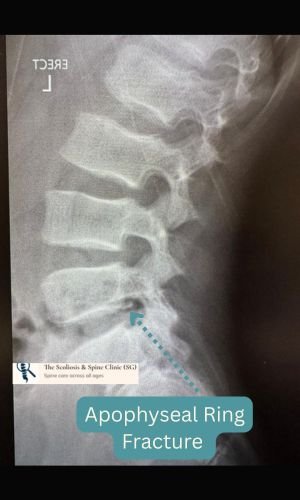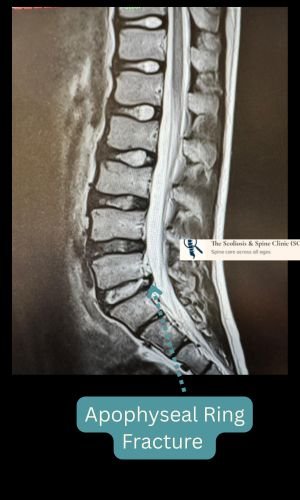Apophyseal Ring Fracture: A Hidden Cause of Adolescent Back Pain
Written by: Dr Lau Leok Lim (drlauspineclinic@gmail.com)
Location: Singapore
Date: 13 September 2025
Apophyseal ring fractures—also known as limbus fractures—are an underdiagnosed cause of back pain in adolescents and young athletes. These injuries affect the bony rim of the vertebral body and often mimic lumbar disc herniation, making them easy to miss on standard X-rays, even by radiologists. Early recognition through advanced imaging is essential to prevent long-term complications and guide appropriate treatment.
Whether you’re a concerned parent, a young athlete, or a clinician seeking clarity, this guide covers everything you need to know—from symptoms and imaging to treatment options and expert insights. The Scoliosis and Spine Clinic (Singapore) is one of the few places in Singapore that specializes in adolescent spinal conditions.
What Is an Apophyseal Ring Fracture?
- Fracture of the vertebral body rim at the ring apophysis
- Common in the lumbar spine, especially L4–L5 and L5–S1
- Typically affects adolescent males engaged in sports
- Often associated with lumbar disc herniation
Why It Happens
- Ring apophysis is a secondary ossification center that fuses around age 18–25
- Before fusion, the junction is cartilaginous and biomechanically vulnerable
- Injury mechanisms include:
- Acute trauma (e.g. sports injury, fall)
- Repetitive microtrauma
- Sudden axial loading or hyperflexion
Clinical Presentation
- Localized back pain after activity or trauma
- Radicular symptoms: leg pain, tingling, or weakness
- Positive straight leg raise test
- May mimic or coexist with disc herniation
Diagnostic Imaging

Lateral lumbar spine X-ray showing posterior apophyseal ring fracture at L5.

Sagittal T2-weighted MRI confirming fracture with no evidence of nerve root compression.
Treatment Options
- Conservative: Rest, NSAIDs, physiotherapy, activity modification
- Surgical: If symptoms persist or fragment compresses nerve root
- Posterior discectomy
- Removal of apophyseal fragment
- Minimally invasive techniques preferred
Case Insight
He stood on the turf—lean, focused—the afternoon sun casting long shadows. His jersey clung to his back, damp with effort. At thirteen, his frame was still growing, but his stance already spoke of discipline.
Knees bent, back slightly arched, he leaned into the moment. His spine was aligned—ready to twist, sprint, or strike.
Then it happened.
He lunged to intercept a pass, twisting sharply. A jolt—sharp and sudden—shot through his lower back. His stick dropped as he froze mid-motion, one hand reaching for the pain. The coach’s whistle cut through the air. “Off the field!” came the call. He walked off slowly, posture guarded, frustration rising.
At home, the pain worsened. He described it as stabbing, radiating to his thigh and calf. Sitting was unbearable, sleep disrupted. He rated it 7 out of 10. Tingling crept down his leg, his calf weakened, and his movements grew cautious.
Painkillers offered brief relief. MRI revealed a posterior apophyseal ring fracture with disc herniation—nerve roots compressed, symptoms explained.
Months of strict rehab followed. Slowly, the pain faded. He could sit through class, walk without discomfort. Normalcy returned—but he wanted more.
Targeted physiotherapy rebuilt his strength and confidence. Each drill restored trust in his body. The hesitation dissolved.
Then came the clearance.
His doctor nodded. His physiotherapist smiled. He grinned wide. The field was no longer a dream—it was waiting.
He laced up, stepped onto the turf. Knees bent, back aligned. The whistle blew. He moved with purpose—not just a player, but a story of resilience.
Final Thoughts
Apophyseal ring fractures are often overlooked but can cause significant morbidity if left untreated. Awareness, appropriate imaging, and timely intervention are essential—especially in young, active patients.
Frequently Asked Questions (FAQ)
Is an apophyseal ring fracture the same as a slipped disc?
No. While both can cause similar symptoms, an apophyseal ring fracture involves a bony fragment from the vertebral rim, whereas a slipped disc refers to herniation of the soft disc material. They may coexist but require different treatment approaches.
Can my child recover without surgery?
Yes, many cases respond well to conservative treatment including rest, physiotherapy, and pain management. Surgery is considered only if symptoms persist or nerve compression is significant.
How is this diagnosed if X-rays look normal?
CT scans are best for detecting the bony fragment. MRI helps assess disc involvement and nerve compression. A thorough clinical evaluation is essential to guide imaging.
Is this condition common in adults?
It’s rare in adults because the apophyseal ring typically fuses by age 25. Most cases occur in adolescents and young athletes during growth phases.
Concerned About Adolescent Back Pain?
If your child or teen is experiencing persistent back pain, leg symptoms, or reduced mobility, an apophyseal ring fracture may be the underlying cause. These injuries are often missed without advanced imaging and specialist evaluation.
At The Scoliosis & Spine Clinic, we offer precise diagnosis and tailored treatment for adolescent spine conditions—including limbus fractures, disc herniation, and growth-related deformities.
📅 Book a Consultation with Dr LauDr Lau Leok Lim is an Orthopaedic Surgeon based in Singapore, with subspecialty expertise in paediatric and adolescent spine care. Trusted by families, referring clinicians, and international peers.
📍 The Scoliosis & Spine Clinic | Singapore
📧 drlauspineclinic@gmail.com
💬 Preferred contact:
WhatsApp Dr Lau
